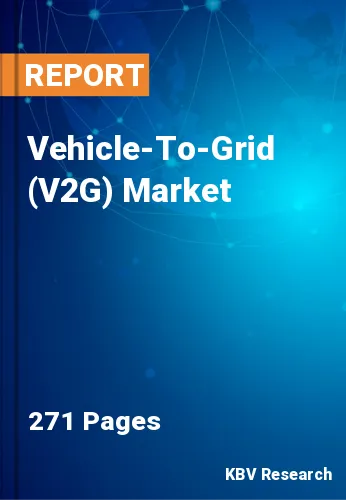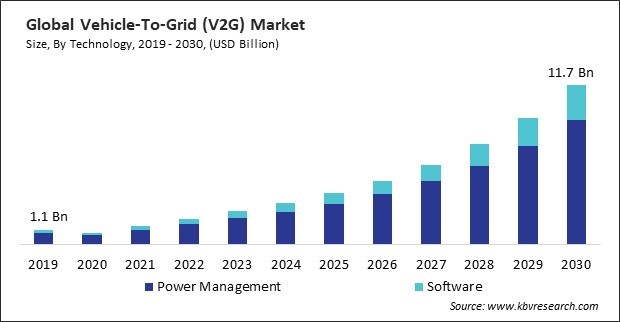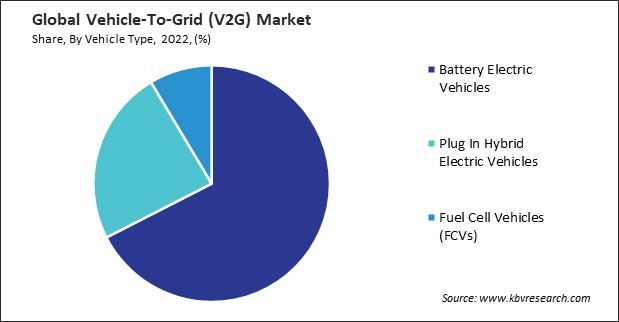
The Global Vehicle-To-Grid (V2G) Market size is expected to reach $11.7 billion by 2030, rising at a market growth of 25.0% CAGR during the forecast period.
Federal, state, and local governments in North America have implemented supportive plans and initiatives to promote electric vehicles (EVs) and V2G technology. Therefore, the Nort-America region captured $611.50 million revenue in the market in 2022. The growth of the electric vehicle (EV) sector in Canada, particularly the rising sales and registrations of battery electric vehicles (BEVs), is closely connected to the expansion and development of the vehicle-to-grid (V2G) market. As EV adoption accelerates, V2G technology is poised to play a key role in shaping the future of sustainable transportation and grid integration in Canada and beyond. According to the Canada Energy Regulator, sales of electric vehicles are rising in Canada and internationally. In 2021, Canada witnessed the registration of a record 86,032 electric vehicles, representing 5.3% of the overall vehicle registrations for that year.

Renewable energy sources like solar and wind power are inherently intermittent and variable. V2G technology allows surplus renewable energy to be stored in EV batteries during periods of high generation. This conserved energy can subsequently be released back into circulation to stabilize the grid when demand surpasses supply. V2G systems optimize the utilization of renewable energy by ensuring that excess energy generated during peak production hours is effectively stored and utilized. This reduces the curtailment of renewable energy and maximizes its contribution to the overall energy mix. Additionally, Technological advancements in battery technology, including lithium-ion and solid-state batteries, have enhanced EV batteries' performance, energy density, and lifespan. These advancements enable EV batteries to store and discharge energy more efficiently, making them well-suited for V2G applications. Developing smart charging infrastructure with bidirectional capabilities is essential for enabling V2G operations. Advanced charging stations equipped with bidirectional power converters allow EVs to charge from the grid and discharge electricity back to the grid as needed, facilitating V2G functionality. Hence, ongoing technological advancements and infrastructure development drive the market's growth.
However, V2G systems involve exchanging sensitive data between electric vehicles (EVs), charging stations, and the grid. This data includes information about energy consumption, charging patterns, grid demand, and user preferences. Any breach of this data could lead to privacy violations and compromise user confidentiality. V2G systems are vulnerable to cybersecurity threats such as hacking, malware, and unauthorized access. Malicious actors could exploit vulnerabilities in V2G infrastructure to disrupt grid operations, manipulate energy markets, or steal sensitive information. Cyber-attacks targeting V2G systems pose risks to grid reliability, consumer trust, and overall system integrity. In conclusion, data and privacy concerns are hampering the growth of the market.
 Drivers
Drivers  Restraints
Restraints  Opportunities
Opportunities  Challenges
Challenges Based on technology, the vehicle-to-grid (V2G) market is categorized into power management and software. The software segment witnessed a considerable revenue share in the vehicle-to-grid (V2G) market in 2022. Software applications facilitate bidirectional communication between EVs, charging infrastructure, and grid operators. They enable real-time monitoring of grid conditions, energy demand, and EV charging status, allowing operators to manage V2G resources, optimize grid operations, and ensure grid stability and reliability.
Based on vehicle type, the vehicle-to-grid (V2G) market is divided into battery electric vehicles, plug in hybrid electric vehicles, and fuel cell vehicles (FCVs). In 2022, the battery electric vehicles segment garnered the highest revenue share in the vehicle-to-grid (V2G) market. The growing demand for electric vehicles worldwide has led to an increase in the number of battery electric vehicles (BEVs) on the road. As more consumers choose electric vehicles for their transportation needs, the potential pool of V2G-enabled vehicles expands, creating greater opportunities for V2G participation and grid services.

On the basis of charging type, the vehicle-to-grid (V2G) market is divided into unidirectional charging and bidirectional charging. In 2022, the bidirectional charging segment registered a remarkable revenue share in the vehicle-to-grid (V2G) market. Bidirectional charging enables electric vehicles (EVs) to charge from the grid and discharge stored energy back into the grid when needed. This capability provides grid operators additional flexibility to manage electricity demand and supply fluctuations, stabilize grid frequency, and support grid reliability and resilience. By leveraging bidirectional charging, EVs can serve as distributed energy resources that enhance the overall stability and efficiency of the electrical grid.
On the basis of components, the vehicle-to-grid (V2G) market is segmented into electric vehicle supply equipment (EVSE), smart meters, home energy management (HEM), and others. The electric vehicle supply equipment (EVSE) segment recorded the largest revenue share in the vehicle-to-grid (V2G) market in 2022. The rising adoption of electric vehicle fleets in various sectors such as transportation, logistics, and public services is driving the demand for EVSE with V2G capabilities. Fleet operators can use V2G technology to optimize the charging and discharging of their EV fleets, reducing operational costs and carbon emissions.
Free Valuable Insights: Global Vehicle-To-Grid (V2G) Market size to reach USD 11.7 Billion by 2030
Region-wise, the vehicle-to-grid (V2G) market is analyzed across North America, Europe, Asia Pacific, and LAMEA. In 2022, the North America region witnessed a substantial revenue share in the vehicle-to-grid (V2G) market. Federal, state, and local governments in North America have implemented supportive plans and initiatives to promote electric vehicles (EVs) and V2G technology. Incentives such as rebates, tax credits, grants, and funding programs encourage consumers, businesses, and utilities to invest in EVs and V2G infrastructure. Regulatory frameworks and mandates prioritize clean transportation and grid modernization, creating a conducive vehicle-to-grid (V2G) market growth environment.
| Report Attribute | Details |
|---|---|
| Market size value in 2022 | USD 1.9 Billion |
| Market size forecast in 2030 | USD 11.7 Billion |
| Base Year | 2022 |
| Historical Period | 2019 to 2021 |
| Forecast Period | 2023 to 2030 |
| Revenue Growth Rate | CAGR of 25.0% from 2023 to 2030 |
| Number of Pages | 271 |
| Number of Tables | 430 |
| Report coverage | Market Trends, Revenue Estimation and Forecast, Segmentation Analysis, Regional and Country Breakdown, Porter’s 5 Forces Analysis, Company Profiling, Companies Strategic Developments, SWOT Analysis, Winning Imperatives |
| Segments covered | Technology, Vehicle Type, Charging Type, Components, Region |
| Country scope |
|
| Companies Included | ABB Group, Denso Corporation, Hitachi, Ltd., Honda Motor Co. Ltd., Indra Sistemas, S.A., Nissan Motor Co., Ltd, NRG Energy, Inc., Toyota Industries Corporation, Fermata Energy, Wallbox N.V. |
By Technology
By Vehicle Type
By Charging Type
By Component
By Geography
This Market size is expected to reach $11.7 billion by 2030.
Integration of renewable energy sources are driving the Market in coming years, however, Concerns associated with data privacy and security restraints the growth of the Market.
ABB Group, Denso Corporation, Hitachi, Ltd., Honda Motor Co. Ltd., Indra Sistemas, S.A., Nissan Motor Co., Ltd, NRG Energy, Inc., Toyota Industries Corporation, Fermata Energy, Wallbox N.V.
The expected CAGR of this Market is 25.0% from 2023 to 2030.
The Power Management segment is leading the Market by Technology in 2022; there by, achieving a market value of $9.1 billion by 2030.
The Europe region dominated the Market by Region in 2022, and would continue to be a dominant market till 2030; there by, achieving a market value of $3.9 billion by 2030.
Our team of dedicated experts can provide you with attractive expansion opportunities for your business.
